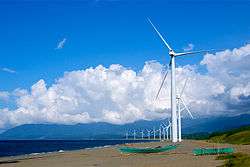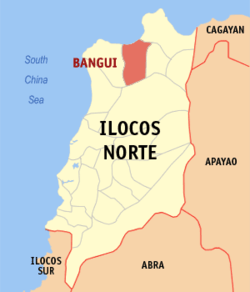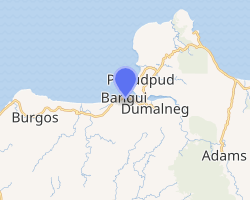Bangui, Ilocos Norte
Bangui, officially the Municipality of Bangui (Ilocano: Ili ti Bangui; Filipino: Bayan ng Bangui), is a 4th class municipality in the province of Ilocos Norte, Philippines. According to the 2015 census, it has a population of 14,672 people.[3]
Bangui | |
|---|---|
| Municipality of Bangui | |
 The Bangui Wind Farm | |
 Seal | |
 Map of Ilocos Norte with Bangui highlighted | |
OpenStreetMap 
| |
.svg.png) Bangui Location within the Philippines | |
| Coordinates: 18°32′N 120°46′E | |
| Country | |
| Region | Ilocos Region (Region I) |
| Province | Ilocos Norte |
| District | 1st District |
| Barangays | 14 (see Barangays) |
| Government | |
| • Type | Sangguniang Bayan |
| • Mayor | Fidel A. Cimatu Jr. |
| • Vice Mayor | Denton Lawrence G. Garvida |
| • Congressman | Ria Christina G. Fariñas |
| • Electorate | 11,516 voters (2019) |
| Area | |
| • Total | 112.98 km2 (43.62 sq mi) |
| Population (2015 census)[3] | |
| • Total | 14,672 |
| • Density | 130/km2 (340/sq mi) |
| • Households | 3,534 |
| Economy | |
| • Income class | 4th municipal income class |
| • Poverty incidence | 8.52% (2015)[4] |
| • Revenue (₱) | 83,376,433.46 (2016) |
| Time zone | UTC+8 (PST) |
| ZIP code | 2920 |
| PSGC | |
| IDD : area code | +63 (0)77 |
| Climate type | tropical monsoon climate |
| Native languages | Ilocano Tagalog |
| Website | www |
The first power generating windmill farm in Southeast Asia, commonly known as Bangui Wind Farm, is found in the municipality of Bangui.
Geography
Bangui is 554 kilometres (344 mi) from Metro Manila and 67 kilometres (42 mi) from Laoag City, the provincial capital.
Barangays
Bangui is politically subdivided into 14 barangays. [2]
- Abaca Fibers
- Bacsil
- Banban
- Baruyen
- Dadaor
- Lanao
- Malasin
- Manayon
- Masikil Clasheras
- Nagbalagan
- Payac
- San Lorenzo (Poblacion)
- Taguiporo
- Utol
Note: Bangui's Barangay San Isidro, by the decision of Supreme Court over the disputed barangay, was transferred to Dumalneg on August 10, 2012.
Climate
| Climate data for Bangui, Ilocos Norte | |||||||||||||
|---|---|---|---|---|---|---|---|---|---|---|---|---|---|
| Month | Jan | Feb | Mar | Apr | May | Jun | Jul | Aug | Sep | Oct | Nov | Dec | Year |
| Average high °C (°F) | 31 (88) |
32 (90) |
33 (91) |
34 (93) |
34 (93) |
34 (93) |
33 (91) |
32 (90) |
32 (90) |
33 (91) |
32 (90) |
31 (88) |
33 (91) |
| Average low °C (°F) | 19 (66) |
20 (68) |
21 (70) |
23 (73) |
24 (75) |
24 (75) |
24 (75) |
24 (75) |
24 (75) |
23 (73) |
22 (72) |
21 (70) |
22 (72) |
| Average rainfall mm (inches) | 6.2 (0.24) |
11.7 (0.46) |
10.1 (0.40) |
14 (0.6) |
192.7 (7.59) |
258.9 (10.19) |
470.9 (18.54) |
475.9 (18.74) |
405.7 (15.97) |
92.5 (3.64) |
44.8 (1.76) |
2 (0.1) |
1,985.4 (78.23) |
| Average rainy days | 3 | 2 | 2 | 2 | 12 | 15 | 20 | 20 | 17 | 10 | 6 | 3 | 112 |
| Source: World Weather Online[5] | |||||||||||||
Demographics
|
| |||||||||||||||||||||||||||||||||||||||||||||
| Source: Philippine Statistics Authority[3][6][7][8] | ||||||||||||||||||||||||||||||||||||||||||||||
In the 2015 census, the population of Bangui was 14,672 people,[3] with a density of 130 inhabitants per square kilometre or 340 inhabitants per square mile.
Local government
As of the term 2016-2019, these are the elected officials of Bangui:[9]
- Mayor: Fidel A. Cimatu, Jr.
- Vice Mayor: Denton Lawrence G. Garvida
- Councilors:
- Joy Soriano
- Florencio Sales
- Diosdado Garvida
- Doodie Gaces
- Susan Faylogna
- Rogerick Balbag
- Anthony Companano
- Florante Garvida
Attractions
Bangui is well known because of its wind farm, which is the town's main attraction. Although the Burgos and Caparispisan (Pagudpud) Windmills were built in 2013, many visitors still visit Bangui Windmills. Bangui Bay is also a tourist spot, yet not practical for swimming because of its deepness and water currents, but it is beautiful to view. There is also Abang Falls that can be found in Barangay Lanao, also a tourist spot. Bangui is also good for its beautiful view of mountains and rivers.
Places to visit:
- Bangui Windmills
- Abang Falls
- Municipal Plaza
- Municipal Hall
- Bolo River (locally known Caramuangen River)
- Bangui Bay View Building
- Bangui's woodcraft windmills souvenir stores
- Bangui Public Market
- Chloe's Burger
Gallery
 Bangui windmills
Bangui windmills- Vestas V82 wind turbines of the Bangui wind farm
References
- "Municipality". Quezon City, Philippines: Department of the Interior and Local Government. Retrieved 31 May 2013.
- "Province: Ilocos Norte". PSGC Interactive. Quezon City, Philippines: Philippine Statistics Authority. Retrieved 12 November 2016.
- Census of Population (2015). "Region I (Ilocos Region)". Total Population by Province, City, Municipality and Barangay. PSA. Retrieved 20 June 2016.
- "PSA releases the 2015 Municipal and City Level Poverty Estimates". Quezon City, Philippines. Retrieved 1 January 2020.
- "Bangui, Philippines: Average Temperatures and Rainfall". World Weather Online. Retrieved 15 September 2014.
- Census of Population and Housing (2010). "Region I (Ilocos Region)". Total Population by Province, City, Municipality and Barangay. NSO. Retrieved 29 June 2016.
- Censuses of Population (1903–2007). "Region I (Ilocos Region)". Table 1. Population Enumerated in Various Censuses by Province/Highly Urbanized City: 1903 to 2007. NSO.
- "Province of Ilocos Norte". Municipality Population Data. Local Water Utilities Administration Research Division. Retrieved 17 December 2016.
- "Official City/Municipal 2013 Election Results". Intramuros, Manila, Philippines: Commission on Elections (COMELEC). 11 September 2013. Retrieved 3 October 2013.
External links
| Wikimedia Commons has media related to Bangui, Ilocos Norte. |